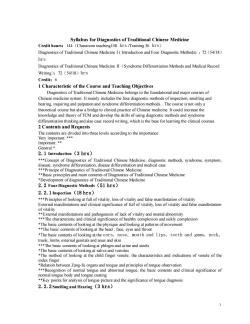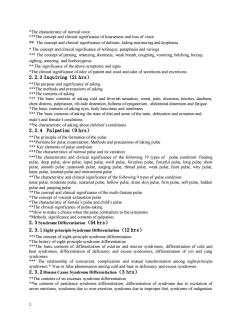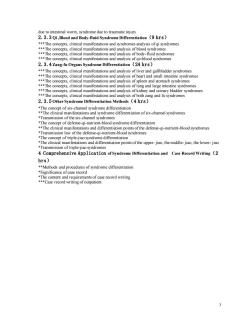北京中医药大学:《中医诊断学》课程教学资源(教学大纲)Dignostics of Chinese Medicine I、II(for Foreign Students)

Syllabus for Diagnostics of Traditional Chinese Medicine Credit hours:144 (Classroom teaching108 hrs /Training 36 hrs) Diagnostics of Traditional Chinese Medicine I Introduction and Four Diagnostic Methods):72 (54/18) hrs Diagnostics of Traditional Chinese Medicine II (Syndrome Differentiation Methods and Medical Record Writing):72 (54/18)hrs Credit:6 1 Characteristic of the Course and Teaching Objectives Diagnostics of Traditional Chinese Medicine belongs to the foundational and major courses of Chinese medicine system.It mainly includes the four diagnostic methods of inspection,smelling and hearing,inquiring and palpation and syndrome differentiation methods..The course is not only a theoretical course but also a bridge to clinical practice of Chinese medicine.It could increase the knowledge and theory of TCM and develop the skills of using diagnostic methods and syndrome differentiation thinking and also case record writing,which is the base for learning the clinical courses. 2 Contents and Requests The contents are divided into three levels according to the importance: Very important:** Important:* General: 2.1 Introduction (3 hrs) ***Concept of Diagnostics of Traditional Chinese Medicine,diagnostic methods,syndrome,symptom, disease,syndrome differentiation,disease differentiation and medical case ***Principe of Diagnostics of Traditional Chinese Medicine **Basic principles and main contents of Diagnostics of Traditional Chinese Medicine *Development of diagnostics of Traditional Chinese Medicine 2.2 Four Diagnostic Methods (51 hrs) 2.2.1 Inspection (18 hrs) ***Principles of looking at full of vitality,loss of vitality and false manifestation of vitality External manifestations and clinical significance of full of vitality,loss of vitality and false manifestation of vitality **External manifestations and pathogenesis of lack of vitality and mental abnormity ***The characteristic and clinical significance of healthy complexion and sickly complexion *The basic contents of looking at the physique and looking at patterns of movement **The basic contents of looking at the head,face,eyes and throat *The basic contents of looking at the ears,nose,mouth and lips,teeth and gums,neck, trunk,limbs,external genitals and anus and skin ***The basic contents of looking at phlegm and urine and stools *The basic contents of looking at saliva and vomitus *The method of looking at the child finger venule;the characteristics and indications of venule of the index finger *Relation between Zang-fu organs and tongue and principles of tongue observation ***Recognition of nommal tongue and abnormal tongue;the basic contents and clinical significance of normal tongue body and tongue coating **Key points for analysis of tongue picture and the significance of tongue diagnosis 2.2.2 Smelling and Hearing (3 hrs) 1
1 Syllabus for Diagnostics of Traditional Chinese Medicine Credit hours:144(Classroom teaching108 hrs /Training 36 hrs) Diagnostics of Traditional Chinese Medicine I ( Introduction and Four Diagnostic Methods) :72(54/18) hrs Diagnostics of Traditional Chinese Medicine II(Syndrome Differentiation Methods and Medical Record Writing):72(54/18)hrs Credit:6 1 Characteristic of the Course and Teaching Objectives Diagnostics of Traditional Chinese Medicine belongs to the foundational and major courses of Chinese medicine system. It mainly includes the four diagnostic methods of inspection, smelling and hearing, inquiring and palpation and syndrome differentiation methods. . The course is not only a theoretical course but also a bridge to clinical practice of Chinese medicine. It could increase the knowledge and theory of TCM and develop the skills of using diagnostic methods and syndrome differentiation thinking and also case record writing, which is the base for learning the clinical courses. 2 Contents and Requests The contents are divided into three levels according to the importance: Very important: *** Important: ** General:*. 2.1 Introduction(3 hrs) ***Concept of Diagnostics of Traditional Chinese Medicine, diagnostic methods, syndrome, symptom, disease, syndrome differentiation, disease differentiation and medical case ***Principe of Diagnostics of Traditional Chinese Medicine **Basic principles and main contents of Diagnostics of Traditional Chinese Medicine *Development of diagnostics of Traditional Chinese Medicine 2.2 Four Diagnostic Methods(51 hrs) 2.2.1 Inspection(18 hrs) ***Principles of looking at full of vitality, loss of vitality and false manifestation of vitality External manifestations and clinical significance of full of vitality, loss of vitality and false manifestation of vitality **External manifestations and pathogenesis of lack of vitality and mental abnormity ***The characteristic and clinical significance of healthy complexion and sickly complexion *The basic contents of looking at the physique and looking at patterns of movement **The basic contents of looking at the head , face, eyes and throat *The basic contents of looking at the ears, nose, mouth and lips, teeth and gums, neck, trunk, limbs, external genitals and anus and skin ***The basic contents of looking at phlegm and urine and stools *The basic contents of looking at saliva and vomitus *The method of looking at the child finger venule; the characteristics and indications of venule of the index finger *Relation between Zang-fu organs and tongue and principles of tongue observation ***Recognition of normal tongue and abnormal tongue; the basic contents and clinical significance of normal tongue body and tongue coating **Key points for analysis of tongue picture and the significance of tongue diagnosis 2.2.2 Smelling and Hearing(3 hrs)

*The characteristic of normal voice ***The concept and clinical significance of hoarseness and loss of voice *The concept and clinical significance of delirum,fading murmuring and dysphasia The concept and clinical significance of soliloquy,paraphasia and ravings **The concept of panting,wheezing,shortness,weak breath,coughing,vomiting,belching,hiccup, sighing.sneezing,and borborygmus *The significance of the above symptoms and signs *The clinical significance of odor of patient and ward and odor of secretions and excretions 2.2.3 Inquiring (21 hrs) **The purpose and significance of asking ***The methods and precautions of asking ***The contents of asking **The basic contents of asking cold and feverish sensation,sweat,pain,dizziness,tinnitus,deafness, chest distress,palpitation,rib-side distention,fullness of epigastrium,abdominal distention and fatigue *The basic contents of asking eyes,body heaviness and numbness **The basic contents of asking the state of diet and sense of the taste,defecation and urination and male's and female's conditions. **he characteristic of asking about children's conditions 2.2.4 Palpation (9 hrs) **The principle of the formation of the pulse ***Portions for pulse examination;Methods and precautions of taking pulse **Key elements of pulse condition ***The characteristics of normal pulse and its variation ***The characteristic and clinical significance of the following 19 types of pulse condition:floating pulse,deep pulse,slow pulse,rapid pulse,swift pulse,forceless pulse,forceful pulse,long pulse,short pulse,smooth pulse ,unsmooth pulse,surging pulse,thread pulse,weak pulse,faint pulse,wiry pulse, hasty pulse,knotted pulse and intermittent pulse **The characteristic and clinical significance of the following 9 types of pulse condition: tense pulse,moderate pulse,scattered pulse,hollow pulse,drum skin pulse,firm pulse,soft pulse,hidden pulse and jumping pulse **The concept and clinical significance of the multi-feature pulse *The concept of visceral exhaustion pulse *The characteristic of female's pulse and child's pulse **The clinical significance of pulse-taking **How to make a choice when the pulse contradicts to the symptoms *Methods,significance and contents of palpation, 2.3 Syndrome Differentiation (54 hrs) 2.3.1 Eight-principle Syndrome Differentiation (12 hrs) ***The concept of eight-principle syndrome differentiation *The history of eight-principle syndrome differentiation ***The basic contents of differentiation of exterior and interior syndromes,differentiation of cold and heat syndromes,differentiation of deficiency and excess syndromes,differentiation of yin and yang syndromes **The relationship of concurrent,complication and mutual transformation among eight-principle syndromes True or false phenomenon among cold and heat or deficiency and excess syndromes 2.3.2 Disease Cause Syndrome Differentiation (3 hrs) **The contents of six excesses syndrome differentiation **he contents of pestilence syndrome differentiation,differentiation of syndrome due to excitation of seven emotions,syndrome due to over-exertion,syndrome due to improper diet,syndrome of indigestion 2
2 *The characteristic of normal voice ***The concept and clinical significance of hoarseness and loss of voice ** The concept and clinical significance of delirum, fading murmuring and dysphasia * The concept and clinical significance of soliloquy, paraphasia and ravings *** The concept of panting, wheezing, shortness, weak breath, coughing, vomiting, belching, hiccup, sighing, sneezing, and borborygmus ** The significance of the above symptoms and signs *The clinical significance of odor of patient and ward and odor of secretions and excretions 2.2.3 Inquiring(21 hrs) **The purpose and significance of asking ***The methods and precautions of asking ***The contents of asking *** The basic contents of asking cold and feverish sensation, sweat, pain, dizziness, tinnitus, deafness, chest distress, palpitation, rib-side distention, fullness of epigastrium , abdominal distention and fatigue *The basic contents of asking eyes, body heaviness and numbness *** The basic contents of asking the state of diet and sense of the taste, defecation and urination and male’s and female’s conditions. **he characteristic of asking about children‘s conditions 2.2.4 Palpation(9 hrs) **The principle of the formation of the pulse ***Portions for pulse examination; Methods and precautions of taking pulse *** Key elements of pulse condition ***The characteristics of normal pulse and its variation ***The characteristic and clinical significance of the following 19 types of pulse condition: floating pulse, deep pulse, slow pulse, rapid pulse, swift pulse, forceless pulse, forceful pulse, long pulse, short pulse, smooth pulse ,unsmooth pulse, surging pulse, thread pulse, weak pulse, faint pulse, wiry pulse, hasty pulse, knotted pulse and intermittent pulse **The characteristic and clinical significance of the following 9 types of pulse condition: tense pulse, moderate pulse, scattered pulse, hollow pulse, drum skin pulse, firm pulse, soft pulse, hidden pulse and jumping pulse **The concept and clinical significance of the multi-feature pulse *The concept of visceral exhaustion pulse *The characteristic of female’s pulse and child’s pulse **The clinical significance of pulse-taking **How to make a choice when the pulse contradicts to the symptoms *Methods, significance and contents of palpation, 2.3 Syndrome Differentiation(54 hrs) 2.3.1 Eight-principle Syndrome Differentiation(12 hrs) ***The concept of eight-principle syndrome differentiation *The history of eight-principle syndrome differentiation ***The basic contents of differentiation of exterior and interior syndromes, differentiation of cold and heat syndromes, differentiation of deficiency and excess syndromes, differentiation of yin and yang syndromes *** The relationship of concurrent, complication and mutual transformation among eight-principle syndromes * True or false phenomenon among cold and heat or deficiency and excess syndromes 2.3.2 Disease Cause Syndrome Differentiation(3 hrs) **The contents of six excesses syndrome differentiation **he contents of pestilence syndrome differentiation, differentiation of syndrome due to excitation of seven emotions, syndrome due to over-exertion, syndrome due to improper diet, syndrome of indigestion

due to intestinal worm,syndrome due to traumatic injury 2.3.3 Qi,Blood and Body-fluid Syndrome Differentiation (9 hrs) ***The concepts,clinical manifestations and syndromes analysis of qi syndromes ***The concepts,clinical manifestations and analysis of blood syndromes ***The concepts,clinical manifestations and analysis of body-fluid syndromes ***The concepts,clinical manifestations and analysis of qi-blood syndromes 2.3.4 Zang-fu Organs Syndrome Differentiation (24 hrs) ***The concepts,clinical manifestations and analysis of liver and gallbladder syndromes ***The concepts,clinical manifestations and analysis of heart and small intestine syndromes ***The concepts,clinical manifestations and analysis of spleen and stomach syndromes ***The concepts,clinical manifestations and analysis of lung and large intestine syndromes ***The concepts,clinical manifestations and analysis of kidney and urinary bladder syndromes ***The concepts,clinical manifestations and analysis of both zang and fu syndromes 2.3.5 Other Syndrome Differentiation Methods (4 hrs) *The concept of six-channel syndrome differentiation **The clinical manifestations and syndrome differentiation of six-channel syndromes *Transmission of the six-channel syndromes *The concept of defense-qi-nutrient-blood syndrome differentiation **The clinical manifestations and differentiation points of the defense-qi-nutrient-blood syndromes *Transmission law of the defense-qi-nutrient-blood syndromes *The concept of triple-jiao syndrome differentiation *The clinical manifestations and differentiation points of the upper-jiao,the middle-jiao,the lower-jiao *Transmission of triple-jiao syndromes 4 Comprehensive Application of Syndrome Differentiation and Case Record Writing (2 hrs) **Methods and procedures of syndrome differentiation *Significance of case record *The content and requirements of case record writing ***Case record writing of outpatient
3 due to intestinal worm, syndrome due to traumatic injury 2.3.3 Qi ,Blood and Body-fluid Syndrome Differentiation(9 hrs) ***The concepts, clinical manifestations and syndromes analysis of qi syndromes ***The concepts, clinical manifestations and analysis of blood syndromes ***The concepts, clinical manifestations and analysis of body-fluid syndromes ***The concepts, clinical manifestations and analysis of qi–blood syndromes 2.3.4 Zang-fu Organs Syndrome Differentiation(24 hrs) ***The concepts, clinical manifestations and analysis of liver and gallbladder syndromes ***The concepts, clinical manifestations and analysis of heart and small intestine syndromes ***The concepts, clinical manifestations and analysis of spleen and stomach syndromes ***The concepts, clinical manifestations and analysis of lung and large intestine syndromes ***The concepts, clinical manifestations and analysis of kidney and urinary bladder syndromes ***The concepts, clinical manifestations and analysis of both zang and fu syndromes 2.3.5 Other Syndrome Differentiation Methods(4 hrs) *The concept of six-channel syndrome differentiation **The clinical manifestations and syndrome differentiation of six-channel syndromes *Transmission of the six-channel syndromes *The concept of defense-qi-nutrient-blood syndrome differentiation **The clinical manifestations and differentiation points of the defense-qi-nutrient-blood syndromes *Transmission law of the defense-qi-nutrient-blood syndromes *The concept of triple-jiao syndrome differentiation *The clinical manifestations and differentiation points of the upper- jiao, the middle- jiao, the lower- jiao *Transmission of triple-jiao syndromes 4 Comprehensive Application of Syndrome Differentiation and Case Record Writing(2 hrs) **Methods and procedures of syndrome differentiation *Significance of case record *The content and requirements of case record writing ***Case record writing of outpatient
按次数下载不扣除下载券;
注册用户24小时内重复下载只扣除一次;
顺序:VIP每日次数-->可用次数-->下载券;
- 北京中医药大学:《中医诊断学》课程教学资源(课件讲稿)Complicated Syndromes of the Zang-Fu Organs.pdf
- 北京中医药大学:《中医诊断学》课程教学资源(课件讲稿)Eight Principle Syndrome Differentiation.pdf
- 湖北中医药高等专科学校:中药学专业人才培养方案(2019年级).pdf
- 世界中医药学会联合会:中药处方、调剂、给付与煎服要求(SCM 52-2020)第1部分 中药处方要求 Requirements for prescription, dispensing, delivery, decoction and taking of Chinese medicine Part 1 Requirements for Prescription of Chinese Medicine.pdf
- 上海中医药大学出版社:《中医基础理论》课程学习记忆手册(便携版,编著:李其忠、张挺.,共八部分).pdf
- 基于人用经验的中药复方制剂新药临床研发指导原则(试行,2022年4月).pdf
- 包头医学院:中医学专业课程教学大纲汇编(2017版).pdf
- 《上海执业药师》电子版(2020年6月,第3期).pdf
- 北京中医药大学:《中药鉴定学》课程教学资源(PPT课件)人参 Radix Ginseng(主讲:张贵君).ppt
- 北京中医药大学:《中药鉴定学》课程教学资源(PPT课件)茎木皮叶花(茎木类中药、皮类中药、叶类中药、花类中药).ppt
- 北京中医药大学:《中药鉴定学》课程教学资源(PPT课件)第1章 绪论、第2章 中药鉴定学的发展历史 Identificology of Chinese Materia Medica.ppt
- 北京中医药大学:《中药鉴定学》课程教学资源(学习指导)各论——概述(含答案).pdf
- 全国高等医药院校规划教材:《中药鉴定学实验指导》课程实验教材电子书(第2版)选择实验(2.10-2.13).doc
- 全国高等医药院校规划教材:《中药鉴定学实验指导》课程实验教材电子书(第2版)选择实验(2.1-2.9).doc
- 全国高等医药院校规划教材:《中药鉴定学实验指导》课程实验教材电子书(第2版)基本实验(1.11-1.15).doc
- 全国高等医药院校规划教材:《中药鉴定学实验指导》课程实验教材电子书(第2版)基本实验(1.1-1.10).doc
- 全国高等医药院校规划教材:《中药鉴定学实验指导》课程实验教材电子书(第2版)封面(科学出版社,主编:张贵君).doc
- 《中草药》:中药辨色论质理论与方法的传承创新(成都中医药大学:刘倩倩).pdf
- 四川省地方标准:川产道地药材认证(DB51/T 2565—2022)通则(代替 DB51/T 2565—2018).pdf
- 北京中医药大学:《中药鉴定学》课程教学资源(试卷练习)动物药复习要点(含习题、模拟试题、答案).doc
- 北京中医药大学:《针灸推拿临床解剖》课程教学资源(PPT课件)针灸推拿临床解剖导论(主讲:薛卫国).ppt
- 北京中医药大学:《针灸推拿临床解剖》课程教学资源(PPT课件)颈项部经穴触摸.ppt
- 北京中医药大学:《针灸学》课程教学资源(课件讲稿)经络腧穴各论——手厥阴经络及腧穴——内关(主讲:赵吉平).pdf
- 北京中医药大学:《药用植物学》课程教学资源(PPT课件)绪论(负责人:白贞芳).ppt
- 北京中医药大学:《药用植物学》课程教学资源(PPT课件)第一章 植物的细胞.ppt
- 北京中医药大学:《药用植物学》课程教学资源(PPT课件)果实的形态.ppt
- 北京中医药大学:《药用植物学》课程教学资源(PPT课件)植物的叶.ppt
- 北京中医药大学:《药用植物学》课程教学资源(PPT课件)植物的器官——植物的根.ppt
- 北京中医药大学:《药用植物学》课程教学资源(PPT课件)植物的茎.ppt
- 北京中医药大学:《药用植物学》课程教学资源(PPT课件)第二章 植物的组织.ppt
- 北京中医药大学:《药用植物学》课程教学资源(PPT课件)花的形态.ppt
- 北京中医药大学:《药用植物学》课程教学资源(PPT课件)忍冬科.ppt
- 北京中医药大学:《中医基本技能训练》课程教学大纲(供中医学专业(实验班)使用).pdf
- 北京中医药大学:《伤寒论》课程教学大纲(供中医学专业(岐黄国医班)使用).docx
- 北京中医药大学:《伤寒论》课程教学大纲(供中医学专业长学制使用).doc
- 北京中医药大学:《伤寒论》课程教学大纲(供中医学专业、中医学专业(养生)使用).doc
- 北京中医药大学:《伤寒论》课程教学大纲(供中医学专业(实验班)使用).doc
- 北京中医药大学:《伤寒论》课程教学大纲(供中医学专业(台港澳)使用).doc
- 北京中医药大学:《伤寒论》课程教学大纲(供中医学专业(留学生)使用).doc
- 北京中医药大学:《伤寒论》课程教学大纲(供中医学专业(全英文授课留学生)使用).doc
